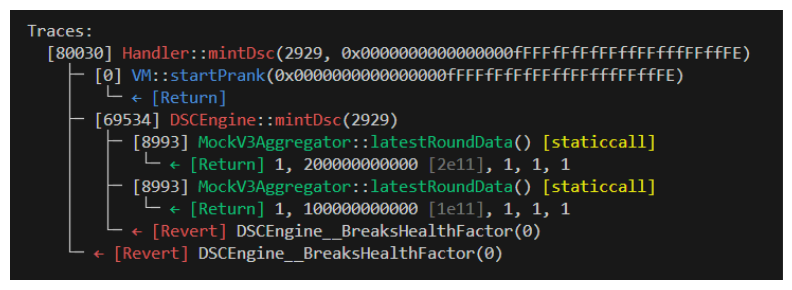5/5
_Follow along the course with this video._ --- ### Handler - mintDsc In the last lesson our stateful fuzz tests were looking great, _but_ the validity of our tests was a little questionable because we haven't configured a way to mint any DSC during our tests. Because our totalSupply was always zero, changes to our collateral value were never going to violate our invariant. Let's change that now by writing a mintDsc function for our Handler. ```solidity function mintDsc(uint256 amount) public {} ``` To constrain our tests, there are a couple things to consider. Namely, we know the `amount` argument needs to be greater than zero or this function will revert with `DSCEngine__NeedsMoreThanZero`. So let's account for that by binding this value. ```solidity function mintDsc(uint256 amount) public { amount = bound(amount, 1, MAX_DEPOSIT_SIZE); vm.startPrank(msg.sender); dcse.mintDsc(amount); vm.stopPrank(); } ``` Another consideration for this function is that it will revert if the Health Factor of the user is broken. We _could_ account for this in our function by assuring that's never the case, but this is an example of a situation you may want to avoid over-narrowing your test focus. We _want_ this function to revert if the Health Factor is broken, so in this case we'd likely just set `fail_on_revert` to `false`. Situations like this will often lead developers to split their test suite into scenarios where `fail_on_revert` is appropriately false, and scenarios where `fail_on_revert` should be true. This allows them to cover all their bases. Let's run our function and see how things look. ```bash forge test --mt invariant_ProtocolTotalSupplyLessThanCollateralValue ```  > ❗ **NOTE** > The `totalSupply = 0` here because of a mistake we made, we'll fix it soon! Ok, so things work when we have `fail_on_revert` set to `false`. We want our tests to be quite focused, so moving forward we'll leave `fail_on_revert` to `true`. What happens when we run it now?  As expected, our user's Health Factor is breaking. This is because we haven't considered _who_ is minting our DSC with respect to who has deposited collateral. We can account for this in our test by ensuring that the user doesn't attempt to mint more than the collateral they have deposited, otherwise we'll return out of the function. We'll determine the user's amount to mint by calling our `getAccountInformation` function. ```solidity function mintDsc(uint256 amount) public { (uint256 totalDscMinted, uint256 collateralValueInUsd) = dsce.getAccountInformation(msg.sender); uint256 maxDscToMint = (collateralValueInUsd / 2) - totalDscMinted; if(maxDscToMint < 0){ return; } amount = bound(amount, 0, maxDscToMint); if(amount < 0){ return; } vm.startPrank(msg.sender); dsce.mintDsc(amount); vm.stopPrank(); } ``` Let's try it!  ### Wrap Up Bam, no reverts at all! Beautiful! You may notice (and I left a note above), our totalSupply seems stuck at 0. Sometimes passing tests can be deceptive... We'll look more closely as what's going on and how we can fix it at the start of our next lesson!
Follow along the course with this video.
Handler - mintDsc
In the last lesson our stateful fuzz tests were looking great, but the validity of our tests was a little questionable because we haven't configured a way to mint any DSC during our tests. Because our totalSupply was always zero, changes to our collateral value were never going to violate our invariant.
Let's change that now by writing a mintDsc function for our Handler.
To constrain our tests, there are a couple things to consider. Namely, we know the amount argument needs to be greater than zero or this function will revert with DSCEngine__NeedsMoreThanZero. So let's account for that by binding this value.
Another consideration for this function is that it will revert if the Health Factor of the user is broken. We could account for this in our function by assuring that's never the case, but this is an example of a situation you may want to avoid over-narrowing your test focus. We want this function to revert if the Health Factor is broken, so in this case we'd likely just set fail_on_revert to false.
Situations like this will often lead developers to split their test suite into scenarios where fail_on_revert is appropriately false, and scenarios where fail_on_revert should be true. This allows them to cover all their bases.
Let's run our function and see how things look.

❗ NOTE
ThetotalSupply = 0here because of a mistake we made, we'll fix it soon!
Ok, so things work when we have fail_on_revert set to false. We want our tests to be quite focused, so moving forward we'll leave fail_on_revert to true. What happens when we run it now?

As expected, our user's Health Factor is breaking. This is because we haven't considered who is minting our DSC with respect to who has deposited collateral. We can account for this in our test by ensuring that the user doesn't attempt to mint more than the collateral they have deposited, otherwise we'll return out of the function. We'll determine the user's amount to mint by calling our getAccountInformation function.
Let's try it!

Wrap Up
Bam, no reverts at all! Beautiful! You may notice (and I left a note above), our totalSupply seems stuck at 0.
Sometimes passing tests can be deceptive...
We'll look more closely as what's going on and how we can fix it at the start of our next lesson!
Create the Mint Handler
A practical guide to Diagnosing Passing Foundry Fuzz Tests - Learn to debug invariant tests that pass despite suspicious logs, focusing on verifying handler execution using ghost variables. Refine handler logic to account for fuzzer randomness and ensure realistic state simulation.
Previous lesson
Previous
Next lesson
Next
Course Overview
About the course
What you'll learn
Advanced smart contract development
How to develop a stablecoin
How to develop a DeFi protocol
How to develop a DAO
Advanced smart contracts testing
Fuzz testing
Manual verification
Course Description
Who is this course for?
- Engineers
- Smart Contract Security researchers
Potential Careers
Web3 Developer Relations
$85,000 - $125,000 (avg. salary)
Web3 developer
$60,000 - $150,000 (avg. salary)
Smart Contract Engineer
$100,000 - $150,000 (avg. salary)
Smart Contract Auditor
$100,000 - $200,000 (avg. salary)
Security researcher
$49,999 - $120,000 (avg. salary)
Meet your instructors
Web3 engineer, educator, and Cyfrin co-founder. Patrick's smart contract development and security courses have helped hundreds of thousands of engineers kickstarting their careers into web3.
Guest lecturers:
Last updated on November 7, 2025
Duration: 36min
Duration: 3h 06min
Duration: 5h 02min
Duration: 6h 02min
Duration: 2h 47min
Duration: 1h 23min
Duration: 4h 28min
Duration: 1h 19min
Duration: 1h 10min
Course Overview
About the course
What you'll learn
Advanced smart contract development
How to develop a stablecoin
How to develop a DeFi protocol
How to develop a DAO
Advanced smart contracts testing
Fuzz testing
Manual verification
Course Description
Who is this course for?
- Engineers
- Smart Contract Security researchers
Potential Careers
Web3 Developer Relations
$85,000 - $125,000 (avg. salary)
Web3 developer
$60,000 - $150,000 (avg. salary)
Smart Contract Engineer
$100,000 - $150,000 (avg. salary)
Smart Contract Auditor
$100,000 - $200,000 (avg. salary)
Security researcher
$49,999 - $120,000 (avg. salary)
Meet your instructors
Web3 engineer, educator, and Cyfrin co-founder. Patrick's smart contract development and security courses have helped hundreds of thousands of engineers kickstarting their careers into web3.
Guest lecturers:
Last updated on November 7, 2025







